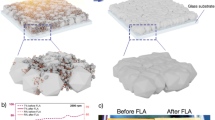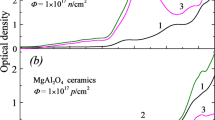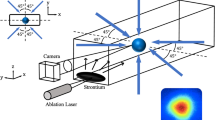Abstract
Saturable absorption is a phenomenon readily seen in the optical and infrared wavelengths. It has never been observed in core-electron transitions owing to the short lifetime of the excited states involved and the high intensities of the soft X-rays needed. We report saturable absorption of an L-shell transition in aluminium using record intensities over 1016 W cm−2 at a photon energy of 92 eV. From a consideration of the relevant timescales, we infer that immediately after the X-rays have passed, the sample is in an exotic state where all of the aluminium atoms have an L-shell hole, and the valence band has approximately a 9 eV temperature, whereas the atoms are still on their crystallographic positions. Subsequently, Auger decay heats the material to the warm dense matter regime, at around 25 eV temperatures. The method is an ideal candidate to study homogeneous warm dense matter, highly relevant to planetary science, astrophysics and inertial confinement fusion.
This is a preview of subscription content, access via your institution
Access options
Subscribe to this journal
Receive 12 print issues and online access
$209.00 per year
only $17.42 per issue
Buy this article
- Purchase on Springer Link
- Instant access to full article PDF
Prices may be subject to local taxes which are calculated during checkout



Similar content being viewed by others
References
Lewis, G. N., Lipkin, D. & Magel, T. T. Reversible photochemical processes in rigid media. A study of the phosphorescent state. J. Am. Chem. Soc. 63, 3005–3018 (1941).
Davidson, R. Frontiers in High Energy Density Physics: The X-Games of Contemporary Science. (National Academies Press, 2003).
Frontiers for Discovery in High Energy Density Physics. Prepared for National Science and Technology Council, Committee on Science by the Interagency Working Group on the Physics of the Universe. (2004).
Guillot, T. Interiors of giant planets inside and outside the solar system. Science 286, 72–77 (1999).
Nettelmann, N. et al. Ab initio equation of state data for hydrogen, helium, and water and the internal structure of Jupiter. Astrophys. J. 683, 1217–1228 (2008).
Turner, M. Connecting Quarks with the Cosmos: Eleven Science Questions for the New Century (National Academies Press, 2003).
Lindl, J. D. et al. The physics basis for ignition using indirect-drive targets on the National Ignition Facility. Phys. Plasmas 11, 339–491 (2004).
Ackermann, W. et al. Operation of a free-electron laser from the extreme ultraviolet to the water window. Nature Photon. 1, 336–342 (2007).
Sorokin, A. A. et al. Photoelectric effect at ultrahigh intensities. Phys. Rev. Lett. 99, 213002 (2007).
Dyer, G., Bernstein, A., Cho, B. & Osterholz, J. Equation-of-state measurement of dense plasmas heated with fast protons. Phys. Rev. Lett. 101, 015002 (2008).
Warm Dense Matter. <http://www.hiper-laser.org/science/extremematerialsscience/warmdensematter.asp>.
Chalupský, J. et al. Characteristics of focused soft X-ray free-electron laser beam determined by ablation of organic molecular solids. Opt. Express 15, 6036–6043 (2007).
Tiedtke, K. et al. Gas detectors for X-ray lasers. J. Appl. Phys. 103, 094511 (2008).
Henke, B. L., Gullikson, E. M. & Davis, J. C. X-Ray Interactions: Photoabsorption, scattering, transmission, and reflection at E=50–30,000 eV, Z=1–92. Atomic Data Nucl. Data Tables 54, 181–342 (1993).
Vinko, S. M. et al. Free–free opacity in warm dense aluminum. High Energy Density Phys. 10.1016/j.hedp.2009.04.004 (2009, in the press).
Dufour, G., Mariot, J., Nilsson-Jatko, P. & Karnatak, R. K-LL auger spectrum of aluminium. Phys. Scr. 13, 370–372 (1976).
Hannah, P. H. & Weightman, P. The spectrum of Al KL2,3–L22,3V satellite Auger transitions. J. Phys. C 18, L239–L243 (1985).
Almbladh, C., Morales, A. & Grossmann, G. Theory of Auger core-valence–valence processes in simple metals. I. Total yields and core-level widths. Phys. Rev. B 39, 3489–3502 (1989).
Kim, D. & Kim, I. Calculation of ionization balance and electrical conductivity in nonideal aluminum plasma. Phys. Rev. E 68, 056410 (2003).
Wefers, K. Properties and characterization of surface oxides on aluminum alloys. Aluminum 57, 722–726 (1981).
Seah, M. P. & Dench, W. A. Quantitative electron spectroscopy of surfaces: A standard database for electron inelastic mean free paths in solids. Surf. Interface Anal. 1, 2–11 (1979).
Ashley, J., Tung, C. & Ritchie, R. Electron inelastic mean free paths and energy losses in solids: I. Aluminum metal. Surf. Sci. 81, 409–426 (1979).
Zastrau, U. et al. Bremsstrahlung and line spectroscopy of warm dense aluminum plasma heated by xuv free-electron-laser. Phys. Rev. E 78, 066406 (2008).
Fabian, D., Watson, L. & Marshall, C. Soft X-ray spectroscopy and the electronic structure of solids. Rep. Prog. Phys. 34, 601–696 (1972).
Pirenne, J. & Longe, P. Contribution of the double electron transitions to the soft X-ray emission bands of metals. Physica 30, 277–292 (1964).
Siwick, B., Dwyer, J., Jordan, R. & Miller, R. An atomic-level view of melting using femtosecond electron diffraction. Science 302, 1382–1385 (2003).
Ernstorfer, R., Harb, M., Hebeisen, C. & Sciaini, G. The formation of warm dense matter: Experimental evidence for electronic bond hardening in gold. Science 323, 1033–1037 (2009).
Ping, Y., Hanson, D., Koslow, I. & Ogitsu, T. Broadband dielectric function of nonequilibrium warm dense gold. Phys. Rev. Lett. 96, 255003 (2006).
Acknowledgements
The authors want to acknowledge K. Budil of LLNL for assistance in support in funding, and acknowledge support for access to FLASH by DESY and the European Community under contract RII3-CT-2004-506008 (IA-SFS). The authors from Universität Rostock are supported by the Deutsche Forschungsgemeinschaft within SFB 652, B.N. by the EU Marie-Curie RTN ‘FLASH’, S.M.V. by EPSRC/STFC, W.M. by AWE, K.S. by the Slovak Grant Agency for Science (Grant No. 2/7196/27) and L.J., J.C., J.Ch. and V.H. by the Czech Ministry of Education (grants LC510, LC528 and LA08024) and Academy of Sciences of the Czech Republic (Z10100523, IAA400100701, and KAN 300100702). Technical assistance by A. Aquila, J. Meyer-Illse and E. M. Gullikson (LBNL) during the ALS beamtime is greatly appreciated. Operation of the Advanced Light Source was supported by the Director, Office of Science, Office of Basic Energy Sciences, of the US Department of Energy under Contract No. DE-AC03-76SF00098. We gratefully acknowledge financial support by the German Federal Ministry for Education and Research through project FSP 301-FLASH, and from the Ministry of Science and Higher Education of Poland through grant SPB No. DESY/68/2007. This work was in part carried out under the auspices of the US Department of Energy by Lawrence Livermore National Laboratory under Contract DE-AC52-07NA27344, and in part supported by grants 08-ERI-002 and 08-LW-004.
Author information
Authors and Affiliations
Consortia
Contributions
All authors contributed extensively to the work presented in this article.
Bob Nagler1, Ulf Zastrau2, Roland R. Fäustlin3, , Sam M. Vinko1, Thomas Whitcher1, A. J. Nelson4, Ryszard Sobierajski5,6, Jacek Krzywinski7, Jaromir Chalupsky8, Elsa Abreu9, Saša Bajt3, , Thomas Bornath10, Tomas Burian8, Henry Chapman11,12, Jaroslav Cihelka8, Tilo Döppner4, Stefan Düsterer3, , Thomas Dzelzainis13, Marta Fajardo9, Eckhart Förster2, Carsten Fortmann10, Eric Galtier14, Siegfried H. Glenzer4, Sebastian Göde10, Gianluca Gregori1, Vera Hajkova8, Phil Heimann15, Libor Juha8, Marek Jurek5, Fida Y. Khattak16, Ali Reza Khorsand6, Dorota Klinger5, Michaela Kozlova9, Tim Laarmann3, , Hae Ja Lee17, Richard W. Lee4, Karl-Heinz Meiwes-Broer10, Pascal Mercere18, William J. Murphy1, Andreas Przystawik10, Ronald Redmer10, Heidi Reinholz10, David Riley11, Gerd Röpke10, Frank Rosmej12, Karel Saksl19, Romain Schott12, Robert Thiele10, Josef Tiggesbäumker10, Sven Toleikis3, , Thomas Tschentscher20, Ingo Uschmann2, Hubert J. Vollmer4, and Justin S. Wark1
Corresponding author
Additional information
A full list of authors and their affiliations appears at the end of the paper.
Rights and permissions
About this article
Cite this article
Bob Nagler et al.. Turning solid aluminium transparent by intense soft X-ray photoionization. Nature Phys 5, 693–696 (2009). https://doi.org/10.1038/nphys1341
Received:
Accepted:
Published:
Issue Date:
DOI: https://doi.org/10.1038/nphys1341
This article is cited by
-
Progress and prospects in nonlinear extreme-ultraviolet and X-ray optics and spectroscopy
Nature Reviews Physics (2023)
-
Coherent correlation imaging for resolving fluctuating states of matter
Nature (2023)
-
Non-linear self-driven spectral tuning of Extreme Ultraviolet Femtosecond Pulses in monoatomic materials
Light: Science & Applications (2021)
-
Simulation and Emulation of X-Ray Diffraction from Dynamic Compression Experiments
Journal of Dynamic Behavior of Materials (2021)
-
Core-level nonlinear spectroscopy triggered by stochastic X-ray pulses
Nature Communications (2019)



